Carbonnade Flamande (Flemish Beef Stew)
Carbonnade Flamande is a tantalizing stew from the heart of Europe. Spoiler alert: I’m a huge fan of soups and stews that warm you from the inside out. If you are too, then you’re in for a treat with this Belgian staple! While dishes like this are typically consumed in winter, Carbonnade Flamande is devoured year-round in Belgium. One taste and you’ll see why! A base of succulent beer-braised beef and sweet caramelized onions yields a delicate balance of flavors both big and bold, comforting and decadent. It doesn’t get any more traditional than this!
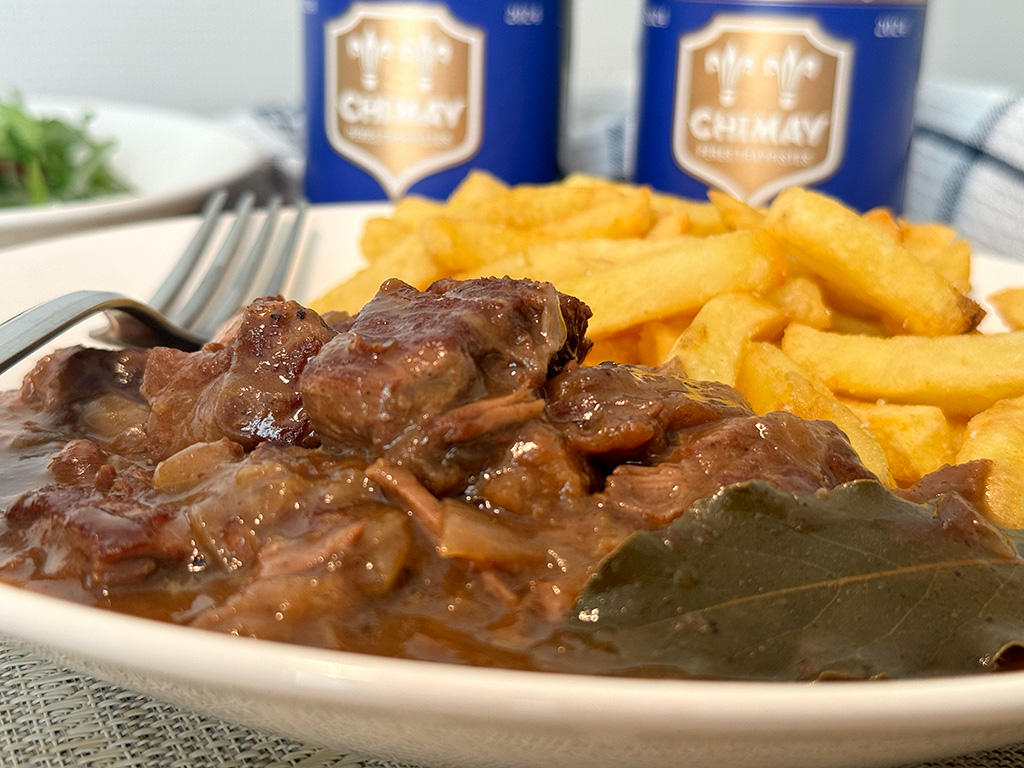
Belgium Is a Foodie Heaven
A dish as tasty as Carbonnade Flamande hailing from Belgium shouldn’t come as a surprise. This sleepy yet striking country wedged between France, Germany, and the Netherlands is home to countless specialties.
Of course, when you think of Belgium, you’re probably thinking of chocolate or waffles. You wouldn’t be wrong. In fact, the Brussels airport sells more chocolate than anywhere else – more than a kilo per minute! And don’t get me started on the waffles, especially the Liege variety, that delightfully dense and chewy nirvana with its morsels of caramelized pearl sugar inside.



But there’s more than just sugary goodies that’ll send your blood sugar soaring like a SpaceX rocket. Savory dishes like moules-frites (mussels with fries), steak-frites, and Carbonnade Flamande populate restaurant menus everywhere. The country even claims to have invented the fry. So don’t ask for french fries here. Another surprising fact: Belgium is home to the 4th most Michelin-starred restaurants per capita. Needless to say, should you find yourself here, bring your appetite!
Then there’s the beer. Belgium is a haven for beer lovers, with a brewing tradition spanning centuries. From fruity lambics to complex Trappist ales, Belgian beer offers a diverse range of flavors that can elevate your cooking to new heights, as this carbonnade rightly proves. The beer’s acidity produces a tenderizing effect while the sugars aid in caramelization during cooking, leaving you with is a dish that’s as deep in flavor as it is in color.
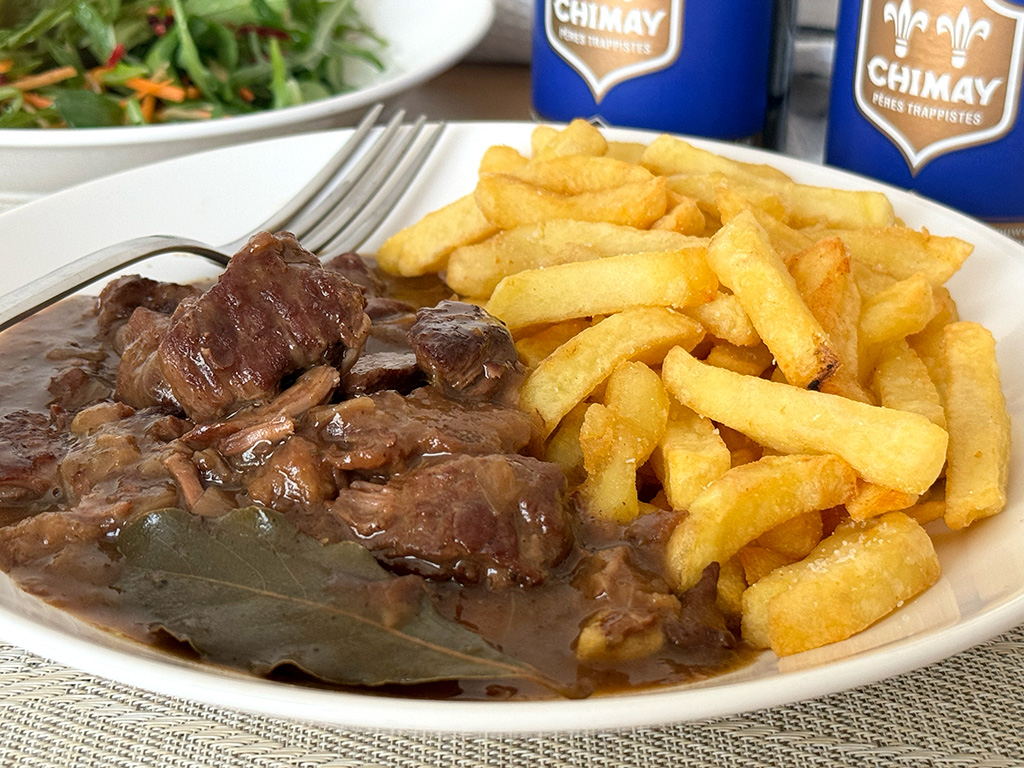
What is Carbonnade Flamande?
For a foodie like me, one of the biggest perks of traveling and living abroad is sampling new delicacies. Full disclosure, I’ve eaten more than my weight in Belgian fries over the past few years.
But it isn’t all gluttony. Gaining insight into local food culture has been a huge part of my culinary journey. One of Belgium’s unique traits is that it’s a trilingual country, with French and Dutch predominant. Carbonnade à la Flamande, or Carbonnade (Flamande) is the French name for this hearty Flemish beef and beer stew; Stoverij or Stoofvlees are its Dutch counterparts.
While this language barrier has a tendency to create divisions in Belgian society, carbonnade is a unifying factor. Everyone has their own recipe. But the only thing more common than Belgians’ shared love for this dish is the rain – it’s ingrained in the culture.
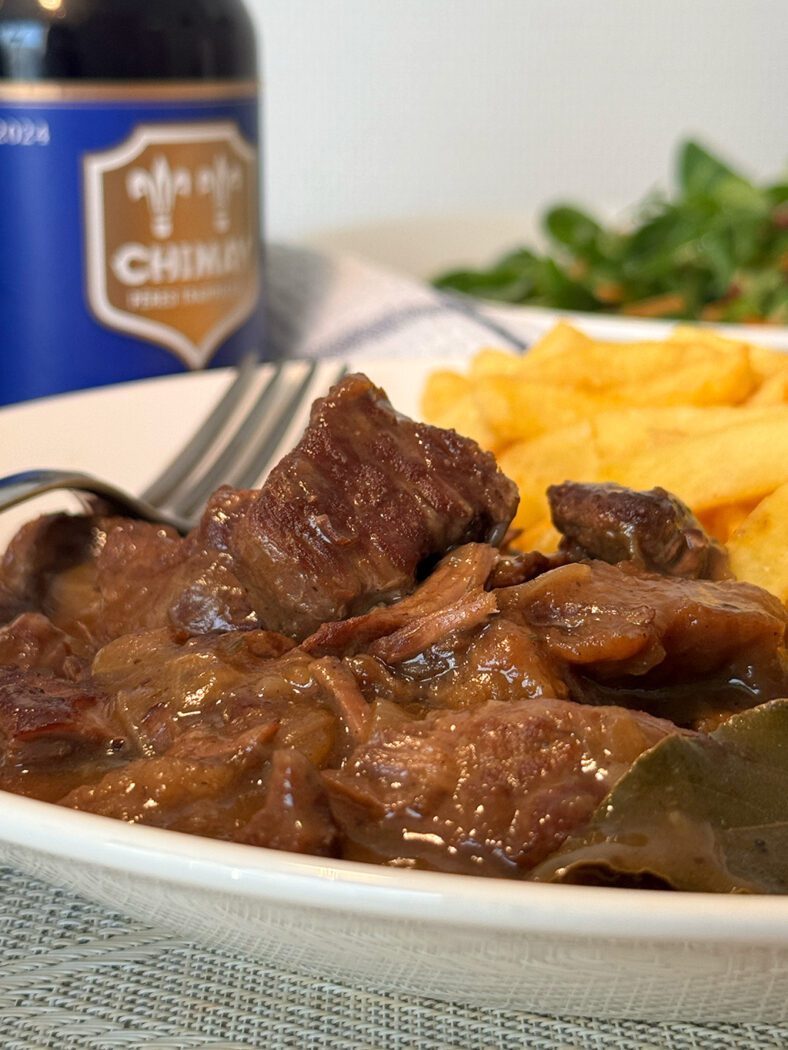
Originally invented by workers in Belgian coal mines, hence the carbon in carbonnade, it’s similar to the French classic Beef Bourguignon, only it ditches the red wine for beer.
Carbonnade Flamande can get one through the long Belgian winters. And trust me, they can be loooong. But it’s equally enjoyed during the delightful summer evenings on one of Brussels’ abundant and charming terraces.
Looking at the ingredients, you can begin to understand why.
- Onions slow-cooked until they’re jammy, sweet, and caramelized
- Beef braised for hours until it melts in your mouth
- Dark beer that reduces into a hearty, slurp-worthy sauce
- Sugar, vinegar, and mustard create a nuanced interplay of sweet and sour
- Herbs and spices like thyme, rosemary, and cloves round out a deep flavor profile
The element that sets carbonnade apart? A piece or two of brown bread is covered with a dollop of mustard and left on top of the stew while it simmers. Traditionally, Belgians use gingerbread, spiking the sauce with extra flavor. It completely dissolves into the stew and acts as a thickening agent, turning the sauce into a luxurious gravy.
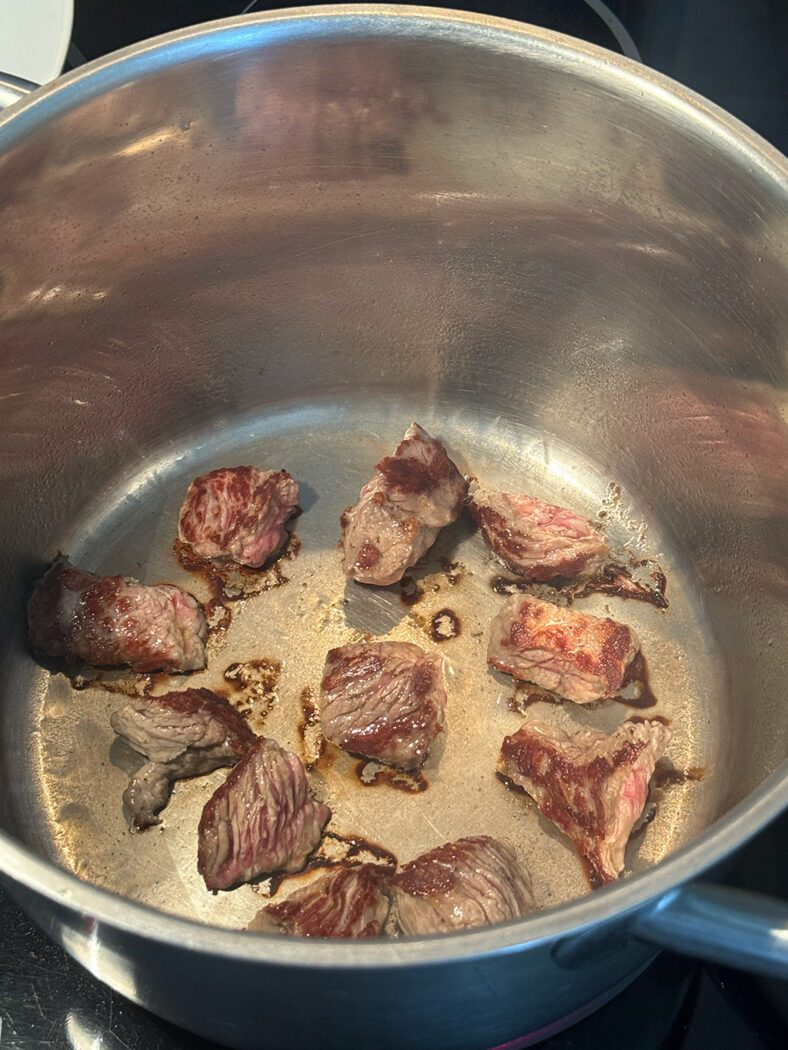
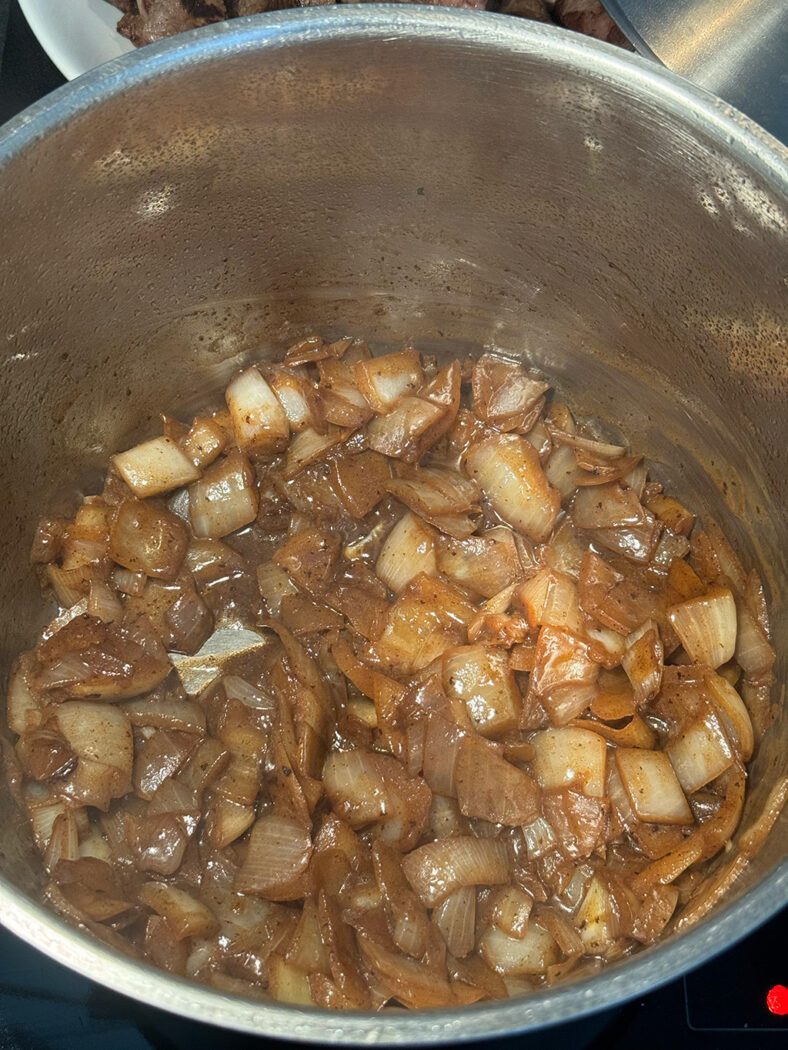
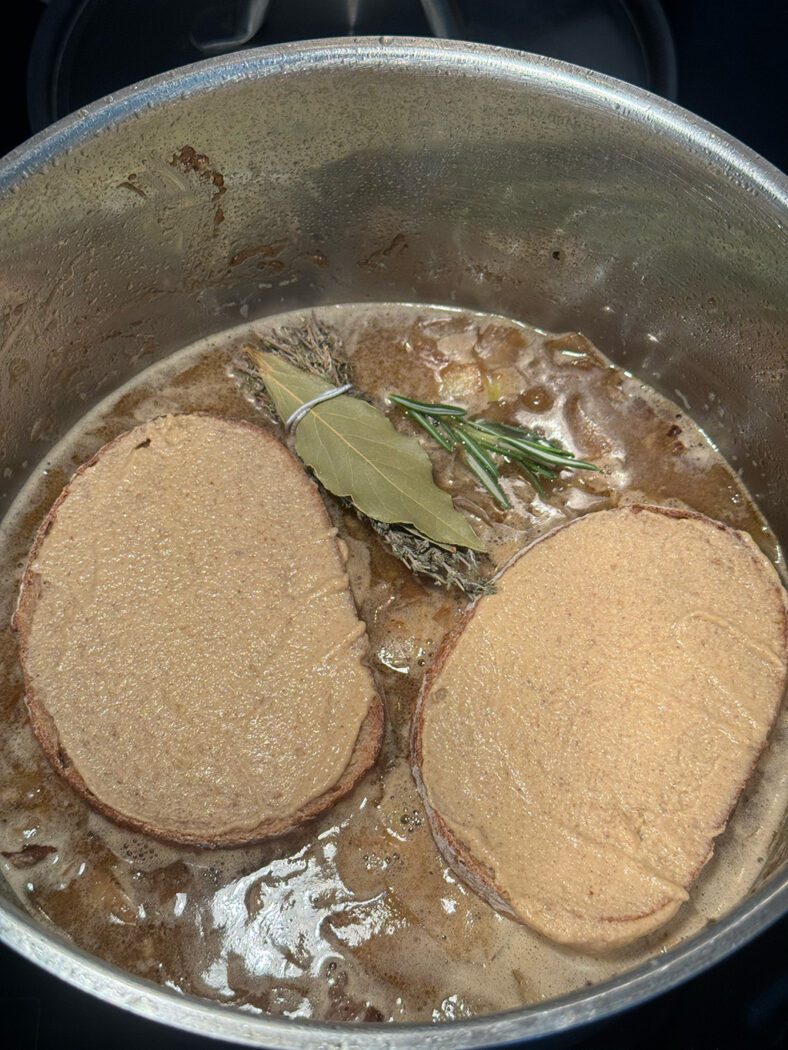
I want to point out that there’s no fast version of Carbonnade Flamande. Cooking it low-and-slow breaks down the collagen-rich meat, transforming it into fork-tender morsels and allowing the flavors to meld together.
Make it at home and it’s sure to become a go-to in your culinary repertoire when you crave something that’s equal parts comforting yet Michelin-worthy. Make it for guests and they’ll be oohing and aahing after each bite over your culinary prowess. It’s THAT good.
Carbonnade Flamande Ingredients
- Extra Virgin Olive Oil
- Beef – Chuck steak, bottom round, or other cuts for stew
- Beer – Chimay, Westmalle Dubbel, Leffe Brown, or any other Belgian-style dark ale; if those are unavailable to you, Newcastle or Guinness work with similar results
- Onions – Roughly cut into chunks
- Garlic – Finely minced or grated
- Butter – Unsalted
- Flour
- Balsamic Vinegar – Apple cider vinegar could be used, as well
- Sugar – Brown or raw cane
- Herbs and spices – Rosemary, thyme, bay leaf, and cloves (the buds removed from the stem and crushed; discard the stems)
- Bread
- Mustard
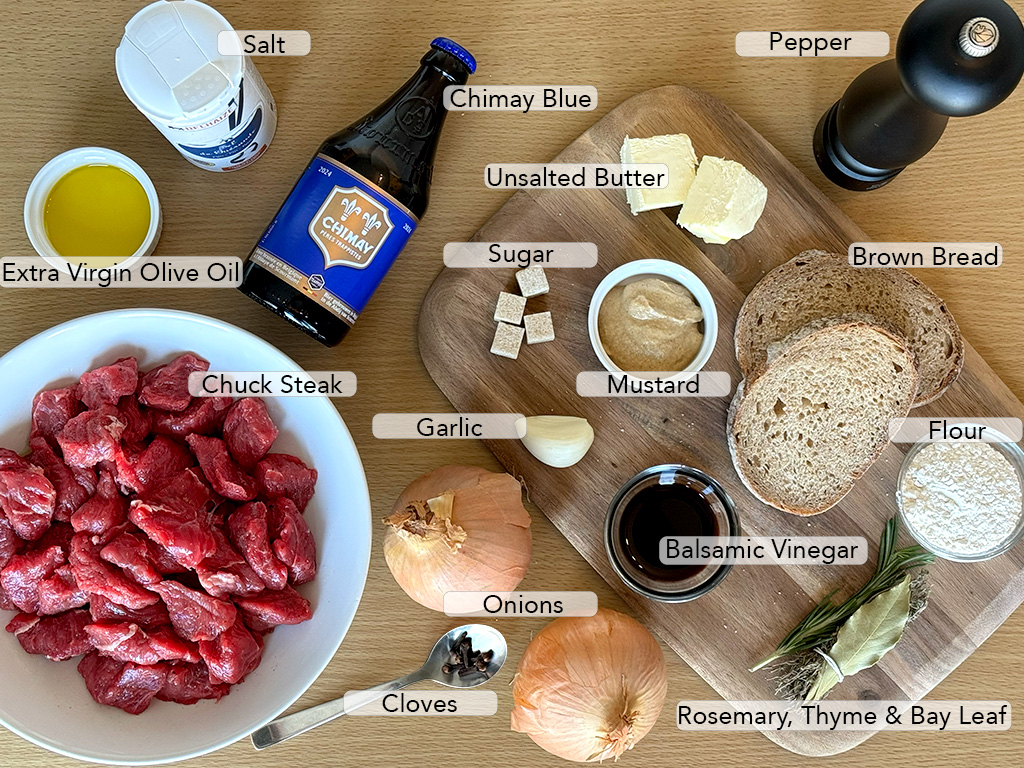
What Kind of Beer to Use?
The right beer to use in Carbonnade Flamande is an endless debate, as illustrated on numerous online forums. Not being Belgian, I’m not going to weigh in too heavily. But, having made carbonnade several times, I prefer a dark Trappist ale. Trappist beers are brewed by Trappist monks. Today, there are 13 Trappist breweries in the world, 6 of which are in Belgium. Among them include Chimay and Westmalle.
I’m using Chimay Blue in this batch of Carbonnade Flamande. It’s a dark brown ale, 9% alcohol by volume with a creamy head and a fruity, chocolatey, slightly peppery flavor profile. Westmalle Dubbel, a red-brown Trappist beer is another bold choice that lends itself to a top-notch stew. If you can’t get your hands on those, Leffe Brown is a worthy option and it’s widely available outside of Belgium. I’ve used it on my own brown ale beef stew.
Unfortunately, outside of Belgium, Belgian beers can cost a pretty penny and you may not want to break the bank on booze you’re going to pour into a stew. Hey, I get it. Luckily, craft breweries all over the world are producing Belgian-style dubbels and tripels which should be available to you. If not, Guinness or Newcastle Brown Ale are excellent stand-ins.
What Kind of Beef to Use?
For the beef, go for a cut that’s rich in flavor and well-marbled, such as chuck or bottom round. These cuts benefit from slow cooking, becoming melt-in-your-mouth tender while infusing the sauce with their beefy goodness.
If there’s too much fat on the beef for your liking, you can trim some of it off before cooking or skim off any excess that accumulates. This way you won’t end up with a greasy stew.
What to Pair with Carbonnade Flamande?
Belgian fries are the classic choice for soaking up that luscious sauce, with crusty bread in a close second. A crisp green salad adds a fresh contrast to the rich flavors of the stew. And of course, don’t forget to pour yourself a glass of your favorite Belgian beer to wash it all down.
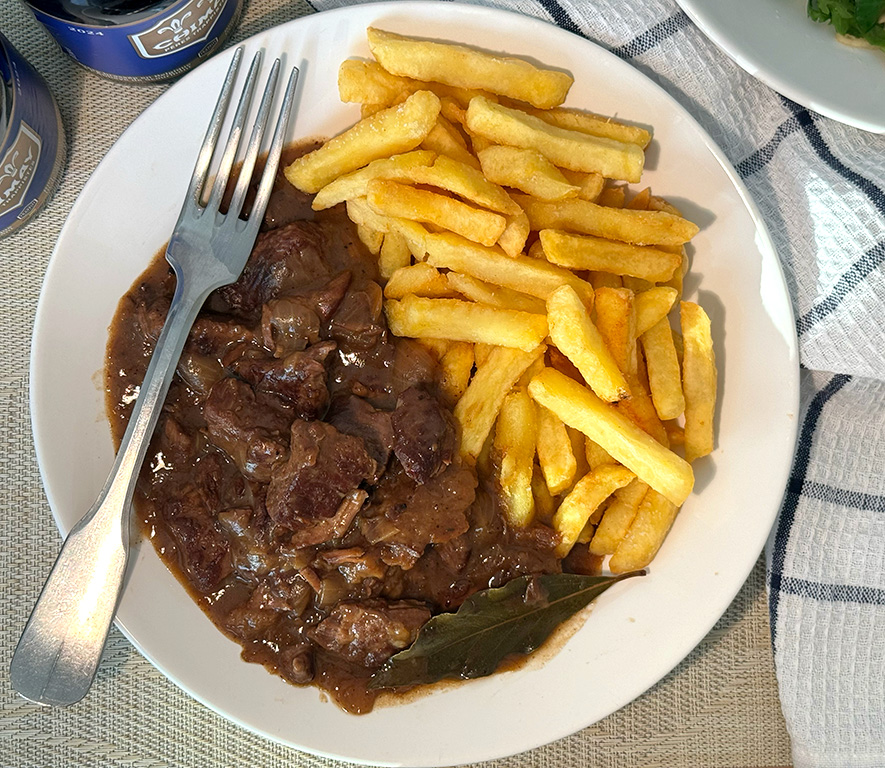
Carbonnade Flamande (Flemish Beef Stew) Recipe
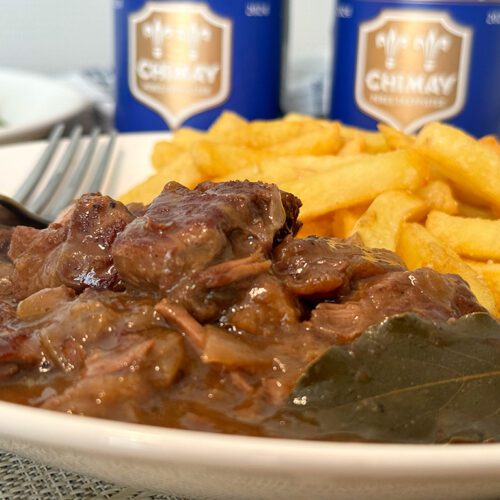
Carbonnade Flamande (Flemish Beef Stew)
Equipment
- Bowl
- Large pot
- Knife
- Cutting board
- Wooden spoon
Ingredients
- 45 ml (3-4 tbsp) Extra virgin olive oil
- 700 g (1½ lbs) Beef Chuck steak, bottom round, or stew meat
- Salt and Pepper to taste
- 660 ml (28oz) Belgian dark beer see notes
- 50 g (3 tbsp) Unsalted butter
- 2 Large onions Yellow, white, or sweet
- 1 clove Garlic
- 45 g (3 tbsp) Flour
- 30 ml (2 tbsp) Balsamic vinegar
- 1 sprig Rosemary
- 3-4 sprigs Thyme
- 1 Bay leaf
- 1 tsp cloves The buds removed from the stems and crushed; discard the stems
- 2 tbsp Sugar Brown or raw cane
- 1-2 slices Brown bread see notes
- 30 g (2 tbsp) Mustard
Instructions
- Season the beef. Place the beef in a bowl and season it with salt, pepper, and extra virgin olive oil.
- Brown the beef. In a large pot, over medium to medium-high heat, brown the beef. Work in batches. It should take about 3-4 minutes per batch. Do not attempt to brown all of the beef at once, which will steam-cook the beef rather than brown it. You want a crust on each piece of beef, as well as a fond on the bottom of the pot. Once the beef is browned, set it aside.
- Deglaze with beer. Once the beef is browned, pour a splash of beer into the pot. Stir with a wooden spoon to deglaze the fond, or stuck-on bits of meat, that has developed in the pan. Do NOT discard this fond. It both flavors and colors the stew.
- Sauté the onions. Reduce the heat to medium-low and add the butter to the pot with the fond. Once melted, add the onions and garlic and sauté until the onions begin to develop a soft, jam-like consistency (about 20 minutes). Equally, you can sauté the onions for longer to caramelize them further. Ensure the heat is low in order to not burn the garlic. If the pot becomes too dry, add a little extra virgin olive oil or butter as necessary.
- Add the flour. Add the flour to the pot and stir to combine. The onion, garlic, and fond mixture should become dry at this point.
- Add the liquid. Add the remaining beer and balsamic vinegar to the pot and stir to combine.
- Return the beef. Return the browned beef to the pot.
- Add the herbs, spices, and sugar. Add the herbs, spices, and sugar to the pot and stir to combine. Bring the pot to a boil and then reduce the heat to low.
- Cover with a slice of brown bread. Spread a dollop of mustard over a slice or two of brown bread and place over the top of the stew.
- Simmer for 2-3 hours. Cover the stew and simmer for 2-3 hours, or until the meat is fork tender, stirring occasionally. Remove the lid and simmer for another 30 minutes uncovered to slightly thicken the sauce.